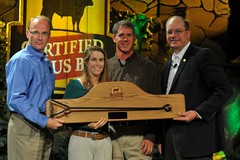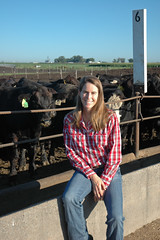“Mama always prays for a nice, pretty, brown Christmas”. These were the words of my middle daughter when she was about 4 years old. She was solemnly telling a friend that her Mama did not like it to snow on Christmas.
In Nebraska during the winter, there is a choice of two colors outdoors: brown and white. While the white can be very aesthetically pleasing, snow brings extra work. While the brown color is not as pretty, it makes chores a lot easier to do!
During my years in New Hampshire at Dartmouth College, I loved the snow. As a native Floridian, it fascinated me. When I moved to Nebraska, my perception changed. Snow no longer represented simple beauty, it’s presence brought added work!
Being the boss lady, it is my responsibility to ensure that our cattle receive good care every single day. In particular, the feed yard is busy during the fall and winter months when animals are moved off of grass pastures as the natural growing season comes to an end. As the days get shorter and the temperatures get colder, good animal care takes more work. Providing fresh feed and water, along with good living conditions for the cattle, is a priority for me.
Last week I was asked by a reader to talk about “winter chores”. Here is a quick run-down on what my crew and I do each day during the winter as we don our coveralls and layers of clothes in order to care for our cattle.
Reading bunks and feeding cattle: My foreman (Doug) and I both read bunks about 6:00am every morning in order to determine how many pounds of feed each animal will receive on our farm that day. Feed trucks are running by 6:30 and breakfast is delivered by 9:00am. My daughters call our afternoon feeding linner (a cross between lunch and dinner), and it is delivered between 2:00pm and 4:00pm.
Exercising calves: I exercise and acclimate newly arrived cattle at the feed yard for the first 4-7 days in order to help them become accustomed to living in a new setting. I do this in the morning before the cattle receive breakfast—during the winter it is usually dark outside! The following video shows the beginning of an exercising session where I ask the cattle to leave the home pen and enter the alleyway.
Processing/vaccinating newly arrived cattle: Newly arrived cattle are vaccinated, ear tagged, and sometimes given a growth promoting implant within the first few days of arrival at the feed yard. My crew and I do this in the middle of the day to try and take advantage of the “warmest hours”.
Scraping pens: At our feed yard, Jared is in charge of cleaning or scraping pens in order to keep the home pens clean and provide good living conditions for the cattle. The manure that is scraped off of the surfaced is used for fertilizer on our farm ground. During the winter months, each pen is scraped 1X per month or more frequently depending on weather conditions. With 24 pens, that means that he is scraping a pen almost every day.

When it’s reasonably warm outside we use the horse to “ride pens”–when it is cold many times we walk through the cattle checking health instead…
Riding pens or checking cattle: My cowboy or I check the health of all of our animals every day. Depending on how cold it is, we either ride a horse or walk through the cattle on foot to check individual cattle health. If an animal is sick, it will be pulled out of the home pen for further evaluation and most likely treated with an antibiotic. Somewhere between 2- 5% of our cattle require antibiotic treatment for an illness. We have a consulting veterinarian who helps us to ensure good cattle health and responsible antibiotic use.

These red angus steers are a few days from shipping to the packing plant. I look pretty small next to them!
Shipping cattle: We ship cattle to the packing plant approximately once every two weeks. My crew and I load the cattle onto semi-trucks to travel to the packing plant.
Receiving cattle: We get new cattle into the feed yard periodically as other cattle are shipped to the packing plant. The new cattle come from neighboring ranches in Nebraska where they were born and spent the first 8-18 months of their lives. I am my own cattle buyer so I travel to the home ranch to help load the cattle onto stock trailers or semi-trucks to bring them to the feed yard.
My crew and I (there are four of us total) each spend an average of 50-60 hours a week during the winter providing care to our animals. We all love what we do and strive for excellence every day.
Karen Ravn




















Being from Buffalo I much prefer snow to anything else winter has to offer but the weather in Michigan is constantly changing – after a nice snow that lasted a few days we got 60 degrees, rain and thunderstorms (resulting in mud on frozen ground), then sleet, then ice and then the big chill with below zero and sustained winds of 25 mph. Now we have snow on top of all that – calving in January can be a real challenge (like this year) or just routine (like last year). Even cows who are well experienced get checked in the middle of the night because even a vigorous baby can have totally frozen hair and ears in a really short period of time. Our calf warmer has been very busy this year – a little work on the front end (warm calf and colostrum) saves a ton of work, stress, money and grief down the road both for the breeder of the calves and the next owner. The importance of that first 24 hours of the long term success of the calf cannot be over estimated – but it is sometimes hard to convince clients who believe “let mother nature take its course” IMHO if you make the choice to calve in rotten cold miserable weather you are MOTHER NATURE and you should do your job! Thanks for the post Anne – I prefer snow, couple feet deep – and about 20 degrees 🙂
I’ll take the 20 degrees, but leave the snow for you! Good luck with the rest of your calving season.
Anne
Snowing, 19 degrees with a “hint” of something resembling sun – 100% so far with the calves – all is good – farmer is tired LOL
Very interesting… hubby and I read it together and learned a lot. the links were helpful too. The video was nice to see also. Hope the snow stays away for the rest of the season, but my Grandma and Uncle said they are predicting more… fingers crossed it wont 😉
We actually really need some moisture, but if I got to choose I would vote for nice spring rains!
Glad that you enjoyed the post–it was filled with lots of info if you clicked on all of the links! I finally figured out how to do them correctly so that you all could easily access the other posts…I am a little slow on the “tech” side of blogging!
Take care,
Anne
They worked for us… I am a little slow on the “tech” side of things too… no worries 🙂
nice looking calves! I’m envious of how CLEAN yours are…I’m always working on that aspect!
Pingback: Critters | Living Simply By Going Backwards
Pingback: Food Trucks are popular out here « ranch wife life
Pingback: Winter Farm Chores: Not always time off for farmers | Agriculture Proud
Pingback: What Do Farmers Do in the Winter? | Iowa Agriculture Literacy